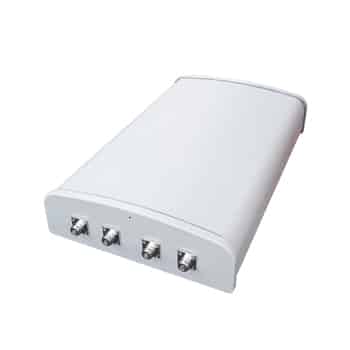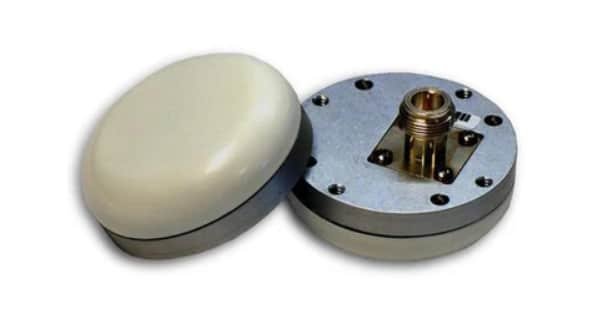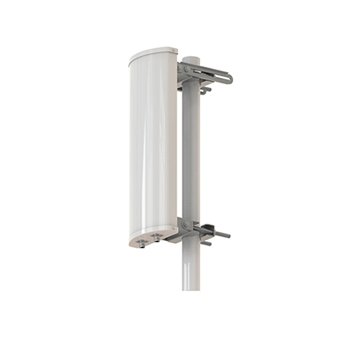
An antenna plays a major role in communication systems as the main component that is responsible for transmitting and receiving signals between the source and the destination. Antennas basically convert electric power into electromagnetic waves and vice versa. There are many types of antennas in different sizes, shapes and performance parameters. The overall performance of a communication system will be heavily dependent on the performance of the antenna and hence it is crucial to select a suitable antenna for the system. This article provides an overview on two of the most common types of antennas, LPDA antennas and Yagi antennas.
Table of Contents
ToggleWhat is a LPDA antenna?
LPDA stands for Logic Periodic Dipole Antenna and is called as such due to the fact that the impedance of this antenna is a logarithmically periodic function of frequency. LPDA antennas are composed of dipole elements that are mounted closely together, parallel, and on either side of the feedline with alternating phase, at specific intervals following a logarithmic function of the frequency. The length of each dipole element decreases towards the front of the antenna. This is a type of multidirectional antenna and can pick up different frequencies due to having elements of different lengths. The spacing of these elements allows for the tuning of the frequency range of the LPDA and determines the performance parameters like gain, directivity, radiation pattern, etc. This makes them ideal for applications where different frequencies have to be transmitted or received at different angles and different frequencies such as WiFi routers, boosters, television antennas, etc.
Advantages of LPDA Antenna
Wide bandwidth: LPDAs cover a broad spectrum of frequencies due to the high bandwidth thus eliminating the need for multiple antennas for different frequency bands. They operate in HF as well as UHF ranges.
High gain: LPDA antennas have a high gain of around 9 to 11 dBi gain, thus enabling focused transmission and reception of signals.
Versatility: LPDA antennas are versatile for a wide range of applications as they can work with multiple different frequencies. This is enabled due to the fact that different elements of the LPDA antenna will be able to transmit and receive signals of different frequencies.
Disadvantages of LPDA Antenna
Size and complexity: LPDA antennas are slightly complex to design and manufacture as they need to contain precise lengths and spacing between elements. Size can be small and compact, however when antennas with high gains or high VSWR performance are required, the length can be quite long.
Cost considerations: LPDA antennas designed for commercial use can be slightly costly as they require quality material and multiple dipole elements in specific sizes.
Gain less than Yagi: because LPDA antenna is designed for wideband, so the highest gain is 11dBi, but Yagi antenna with a narrow beamwidth that allow it reach to 17-20dBi maximum.
What is a Yagi antenna?
Yagi antennas look slightly similar to LPDA antennas. But unlike LPDA antennas, Yagi antennas are highly directional and typically work on either one frequency or a very small range of frequencies. The main components of a Yagi antenna are the central boom on which the other elements are connected, a main driving element that transmits or receives signals primarily, a reflector at the end that reflects the signals towards the radiation pattern, and the director elements on either side of the boom that helps to focus all the reflected signals towards the radiation pattern. In a Yagi antenna, the driving element generates electromagnetic waves and the reflector element placed behind the driving element reflects those waves forward such that the directors placed in the front direct and focus the reflected waves forward. Yagi antennas are ideal for applications that require the signal to be focused on a particular direction such as radars and long distance point to point communication systems.
Advantages of Yagi Antenna
High directivity: Yagi antennas generally have a beamwidth of about 8 to 50 degrees. Since they focus all signals in a shorter field angle, they have very high directivity compared to multidirectional or omnidirectional antennas.
Simple design: Yagi antennas are pretty simple to construct as they have same length passive elements placed at fixed intervals along a rod. Although there are some advanced printed yagi antennas, generally they can be constructed with readily available materials.
Cost-effectiveness: Yagi antennas are widely available inexpensively. Even the equipment and maintenance components for Yagi antennas can be found at lower cost. Considering the high gain and high directionality offered by Yagi antennas, they are very cost effective.
Disadvantages of Yagi Antenna
Narrow bandwidth: Yagi antennas provide high gain but only for a limited bandwidth of about 45 to 90 degrees and hence they become very application specific and less versatile.
Limited frequency range: Yagi antennas are typically built to either work with one frequency or a very small range of frequencies. Beyond this range, the signal reception or transmission ability is very poor.
Comparison between LPDA antennas and Yagi Antennas
| Yagi Antenna | LPDA Antenna | |
| Frequency range | Narrow | Broad: normally 400-6000MHz |
| Peak gain | 17dBi | 11dBi |
| Antenna size | Larger than LPDA | 43cm length max |
| Wind load | Small | Bigger than Yagi |
| Cost | High | lower than Yagi |
Design and construction:
LPDA antennas typically have a triangular structure. They are composed of multiple conductive elements with different lengths and distances from each other arranged in a specific pattern along a boom-like structure. Yagi antennas have a more linear structure with multiple director elements of relatively the same length arranged in an array along a boom-like structure similar to a LPDA. Yagi antennas are slightly easier to construct and manufacture as they have similar length elements. LPDA antennas are slightly more complex in design and manufacture. Both LPDA and Yagi antennas are quite similar in terms of installation and maintenance. However, Yagi antennas require more attention during installation as they require precise alignment for optimal performance in a specific direction.
Performance parameters:
LPDA antennas generally operate in frequency ranges between 30 to 4200 MHz and Yagi antennas between 30 to 3000 MHz. But both LPDA and Yagi antennas are also available in much greater frequency ranges depending on the manufacturer. LPDA antennas have a broad radiation pattern compared to Yagi antennas which typically have a narrow bandwidth. Yagi antennas are highly directional and hence focus signals on an angle of about 45 degree to 90 degree field. LPDA antennas due to their structure with elements of different lengths and spacing, are able to cover a much wider angle in terms of directivity. Yagi antennas have a higher gain compared to LPDA antennas but both antennas are generally considered as high gain directional antennas compared to other types.
Application scenarios:
LPDA antennas are usually used in communication systems that need to transmit and receive signals simultaneously in multiple directions and multiple frequencies such as LPWAN, LoRa, LTE-M, NB-IoT, IoT, M2M applications, etc. Yagi antennas with their narrow frequency range and high directionality are used typically in point-to-point communication systems and for broadcast, domestic, and commercial radio communication applications.
Cost Considerations:
Initial investment is generally in a similar range for both LPDA and Yagi antennas. However, LPDA antennas are usually considered to be more cost-effective as they can be used as a versatile solution for many applications. Although both types of antennas are approximately similar in maintenance costs, Yagi antennas might need more periodic maintenance in order to maintain the optimum performance for their highly directive and specific use cases.
Real World Applications
Log Periodic Antennas
Broadcasting: LPDA antennas are commonly used in both radio and television broadcasting due to their ability to cover a broad spectrum of frequencies. This makes it possible to transmit signals across various channels providing coverage in urban and remote areas alike.
Military and defense: LPDA antennas are widely used in aircraft, satellites, radar systems, military equipment etc. for defense and safety applications. LPDA antennas are ideal for critical missions and surveillance operations in the military due to their durability, bandwidth, and directional characteristics.
Yagi Antennas
Amateur radio: Yagi antennas are commonly used in amateur radio communications due to their high gain and directionality. Since Yagi antennas are efficient in reducing interference from other sources, they are ideal for environments with high radio traffic. They can be used to establish reliable links across vast geographical areas without degrading signal quality.
Television reception: Yagi antennas are very useful, particularly in areas with weak or distant broadcasting stations. Due to the high directionality and high gain, they can effectively capture signals from far-off broadcast towers thus improving the quality of television reception.
Conclusion
Antennas can be considered as the most crucial component of a communication system. Their performance will have a key impact on the overall quality of the communication system. Selecting an antenna for a specific application will depend on the performance requirements as well as environmental conditions, cost considerations, ease of installation and maintenance, etc. This article provided a brief overview of the LPDA and Yagi antennas and how they compare against each other. For applications that require a better signal on one frequency band, the Yagi antenna is the better option while for applications that require an antenna that is versatile for a wide frequency range, the log periodic antenna is a better choice. But to select an optimal antenna for an application, it is important to take all factors into account, and also consultation with antenna experts and manufacturers can be beneficial.








